|
- Losi -
Losi tyres are available in the following compounds:
Violet (V): Those compound tires are the firmest tires. Due to their firmness these tires are excellent for on-road driving, and are recommended for use as front tires on asphalt or concrete.
Green (G): Those tires offer maximum traction and durability on a wide range of track conditions. This compound provides optimum handling on both wet and dry surfaces.
Silver (S): The most common and reliable Team Losi compound works well under varying conditions and is exceptional on blue-groove and soft surfaces.
Red (R): The Team Losi soft compound that picks up where Silver stops, this soft/sticky formula works well on dry, hard, slick surfaces. This compound tires provide exceptional bite and tread life. This compound is commonly used on dry hardpacked outdoor racetracks. Very safe compound for all conditions.
White (W): Those compound tires will provide increased grip and traction on most surfaces, and are proven to perform very well in cold weather conditions.
Pink (P): The newest Team Losi soft compound that offers traction similar to Red with handling characteristics similar to Silver. This compound is commonly used when racing indoors and typically performs best on high-traction or “tacky” surfaces.
Blue (B): Those compound tires perform best in warm outdoor conditions that are hard-packed rock or dirt surface. Blue compound tires are commonly used for rock crawling.
What types of tires work best indoors?
Using micro pin tires on the front and rear wheels of the car will provide a larger overall contact patch with the surface. Pink compound tires tend to work best in this situation, although a Red compound front tire can mellow out the steering if it is overly aggressive or twitchy.
What types of tires work best on sand or loose soil?
A tread pattern with a large lug and wide spacing between each lug performs best in this type of environment. The large lug allows the tire to bite down into the soft surface and create traction. Silver or Blue compounds work best because they give the tire rigidity needed to claw through the loose soil.
What types of tires work best during wet conditions?
Many different pin styles can be used to fine-tune handling and traction characteristics, but often a medium size pin is a good starting point. Red compound tires provide excellent grip and conform to the changing features and ruts of the track. In certain conditions experimenting with Pink or Blue compounds can also yield positive results, but only if the track remains consistently damp without becoming muddy.
| Tire |
|
Red |
Pink |
Silver |
| |
|
|
|
|
3-Rib BK Pre-Scrubbed (2wd)
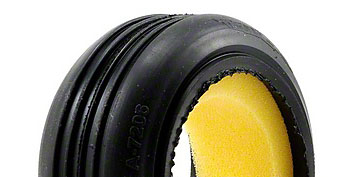 |
|
|
LOSA7206P |
|
| |
|
|
|
|
Taper Pin (2wd)
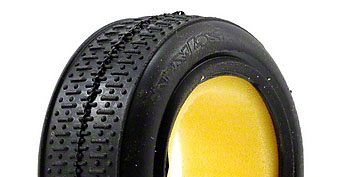 |
|
LOSA7207R |
LOSA7207P |
LOSA7207S |
| |
|
|
|
|
Wide Body Rib (2wd)
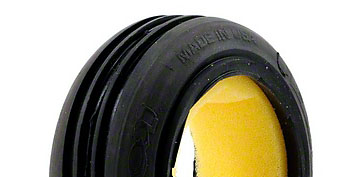 |
|
LOSA7202R |
LOSA7202P |
LOSA7202S |
| |
|
|
|
|
BK-Bar 2.2" (4wd)
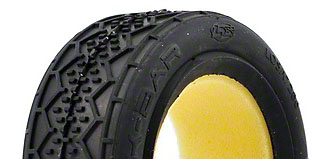 |
|
LOSA7286R |
LOSA7286P |
|
| |
|
|
|
|
Blockhead 2.2" (4wd)
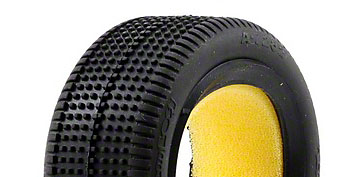 |
|
LOSA7282R |
|
|
| |
|
|
|
|
IFMAR Stud 2.2" (4wd)
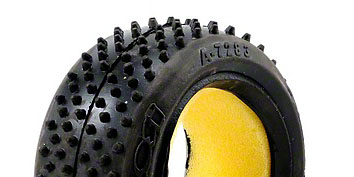 |
|
LOSA7283R |
|
LOSA7283S |
| |
|
|
|
|
Taper Pin 2.2" (4wd)
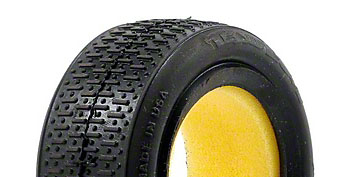 |
|
LOSA7285R |
LOSA7285P |
LOSA7285S |
| |
|
|
|
|
Big Shot 2.2" (Rear)
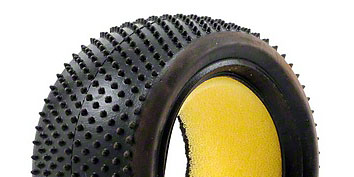 |
|
LOSA7368R |
|
|
| |
|
|
|
|
BK-Bar 2.2" (Rear)
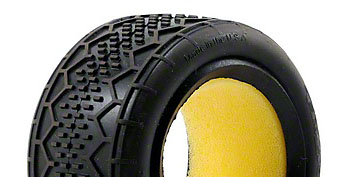 |
|
LOSA7371R |
LOSA7371P |
|
| |
|
|
|
|
IFMAR Pin 2.2" (Rear)
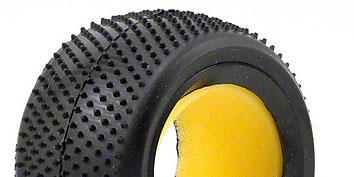 |
|
LOSA7367R |
|
|
| |
|
|
|
|
IFMAR Stud 2.2" (Rear)
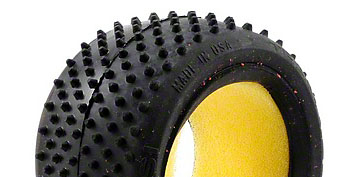 |
|
LOSA7364R |
|
LOSA7364S |
| |
|
|
|
|
Step Pin 2.0" (Rear)
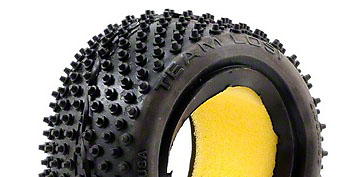 |
|
|
|
LOSA7378S |
| |
|
|
|
|
Taper Pin 2.2" (Rear)
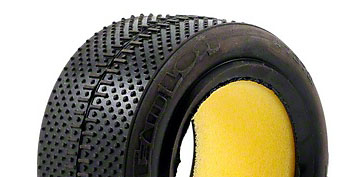 |
|
LOSA7372R |
LOSA7372P |
|
| |
|
|
|
|
X-2000 2.2" (Rear)
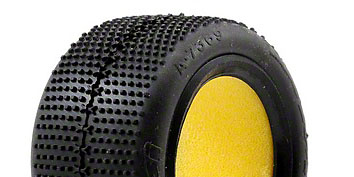 |
|
|
LOSA7369P |
|
| |
|
|
|
|
X-3000 2.2" (Rear)
 |
|
LOSA7360R |
LOSA7360P |
|
Effect of foam inserts on tires' performance
Unlike full-size car or truck tires, RC tires do not use air. Foam inserts are used to maintain the shape and increase the performance of your tires. The characteristics of the foam insert will have a direct effect on a tire’s handling and response, so it is imperative that your tire inserts are ideal for the running surface.
Characteristics of standard foam inserts
Standard foam inserts feature a flat exterior with squared edges, and typically offer a firm density. With a proper fit, these inserts will completely fill and support the tire carcass. This type of foam insert is recommended for use on smooth track surfaces.
Characteristics of molded foam inserts
Molded inserts feature a contoured design that matches the interior of the tire carcass. One of the biggest advantages to using molded inserts is that they are constructed from a material that will not break down, so they can be reused. Molded inserts also offer consistent pressure for improving the overall handling of your vehicle.
| Inserts |
|
|
|
|
|
7297 - 4wd Foam Insert Firm
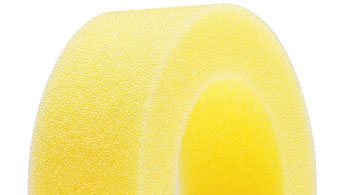 |
|
|
|
|
|
7398 - Rear Foam Insert Firm
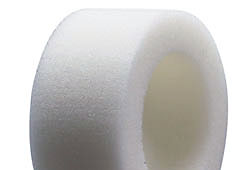 |
|
|
Tire Grading: A=Excellent B=Good C=Fair (-)not recommended
Looking at the chart for A-7202 Wide Body from left to right, in Sand it is not recommended in "Pink" (P) compound, it is "Good" in the Red (R) compound and is considered "Excellent" in the "Silver" (S) compound.
If a compound has a (-) for a recommendation, that means it is not recommended for that surface. Example: A7202 Wide body in the Pink (P) compound is not recommended for Sand.
If a Tire Pattern has a empty box under a surface that means it is not recommended for that surface in any compound. Example:A-7282 4wd Blockhead is not recommended for any Soft Surfaces.
Hard Slick: surface packs but does not take rubber.
Abrasive: natural abrasion also accelerates wear.
Ruts: holes, ridges, or scaling of the track.
Wet: a condition where the surface has moisture on it or in it.
Blue Groove: rubber is laid creating a dark groove.
Sand/Soil: loose sand or topsoil covers parts of the surface.
Broken: the surface breaks up giving multiple conditions.
Tire Construction: Tires are a combination of the tread/carcass design and the rubber compound. The construction/tread affects the way the tire reacts to directional loading and how it presents the compound to the track surface. The compound affects the way a tire handles surface irregularities as well as the friction or bite as it contacts the surface.
|
Soft Surface |
Hard Surface |
| Sand |
Soil |
Wet |
Dry |
Ruts |
Slick |
B-grv |
Wet |
Dry |
Damp |
Abras. |
Broken |
Dust |
| P=Pink R=Red S=Silver |
PRS |
PRS |
PRS |
PRS |
PRS |
PRS |
PRS |
PRS |
PRS |
PRS |
PRS |
PRS |
PRS |
| 2wd |
LOSA7202 |
Wide Body |
-BA |
-BA |
-AA |
-BA |
-AB |
-CA |
-BA |
-AB |
-BA |
-AA |
-AA |
-BA |
-AA |
| 2wd |
LOSA7204 |
X-Wide Body |
BBB |
BBB |
AAB |
BBA |
BBB |
BBA |
BBB |
AAB |
BBA |
AAA |
AAA |
BBA |
ABB |
| 4wd |
LOSA7282 |
4wd Blockhead |
|
|
|
|
|
CBA |
BBA |
AAB |
BBA |
AAA |
AAA |
BBA |
ABB |
| 4wd |
LOSA7283 |
4wd Stud |
--A |
--A |
--A |
--A |
--A |
|
|
|
|
--B |
|
--B |
|
| 4wd |
LOSA7284 |
4wd Sprint |
|
|
|
|
|
-CC |
-AA |
-BB |
-CB |
-BB |
-BB |
--B |
|
| 4wd |
LOSA7285 |
4wd Taper-Pin |
|
|
|
|
|
CCA |
BBA |
AAA |
BBA |
AAA |
AAA |
BAA |
BAA |
| Rear |
LOSA7364 |
IFMAR Stud |
-AA |
-AA |
-BA |
-AB |
-AB |
|
|
|
|
|
--C |
|
-CC |
| Rear |
LOSA7367 |
IFMAR-Pin |
-BB |
-BB |
-BB |
-AB |
-AB |
-BC |
|
--B |
-BC |
|
|
-BC |
-BC |
| Rear |
LOSA7368 |
Big Shot |
-BB |
-BB |
-BB |
-AB |
-AB |
-BB |
|
-CB |
-BC |
|
|
-BC |
-AB |
| Rear |
LOSA7369 |
X-2000 |
|
|
|
|
|
AAB |
BBA |
ABA |
AAA |
ABA |
AAA |
AAA |
AAA |
| Rear |
LOSA7371 |
BK-Bar |
|
|
|
|
|
AAB |
BBA |
BBA |
AAB |
A-A |
A-A |
ABB |
BBB |
| Rear |
LOSA7372 |
Taper-Pin |
|
|
|
|
|
AAB |
BBA |
BBA |
AAA |
BBA |
AAA |
AAB |
BBB |
| Rear |
LOSA7378 |
2.0 Step-Pin |
--A |
--A |
--A |
--A |
--A |
|
|
|
|
|
|
|
--C |

Release: May 2013
For any add-on, comments or correction, contact arn0 at petitrc dot com
|
|
